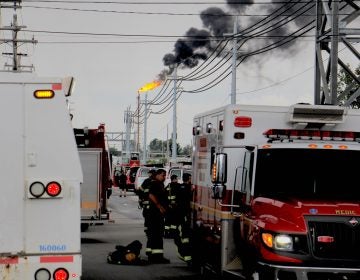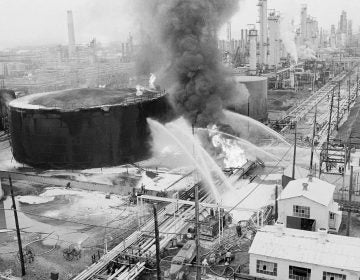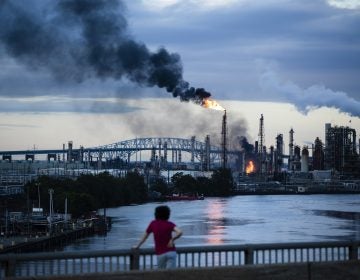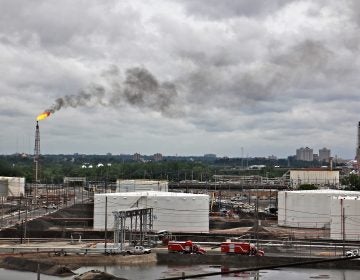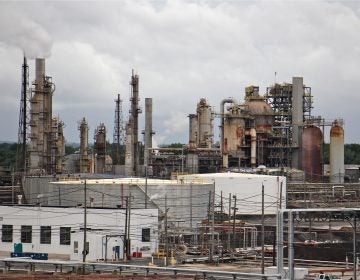Feds to investigate refinery explosion; local health officials remain cautious
A series of explosions that produced a giant fireball at the refinery early Friday led to plumes of black smoke and noxious odors that spread across the region.
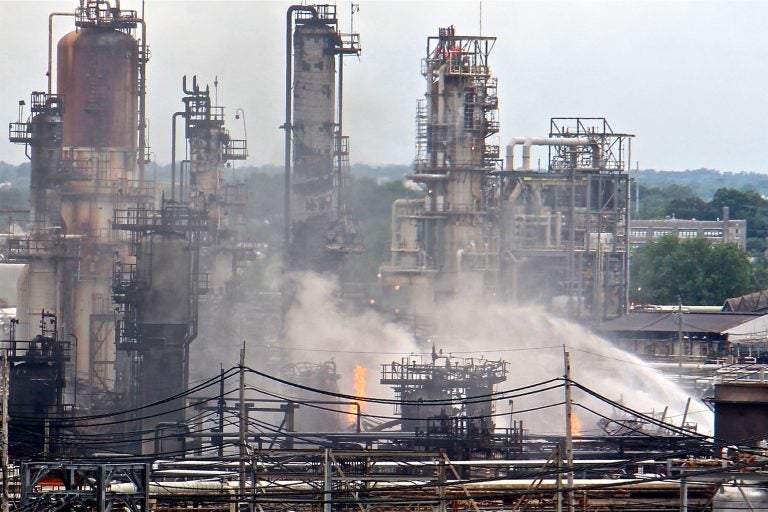
A fire burns at the Philadelphia Energy Solutions refinery hours after a series of early morning explosions at the 150-year-old industrial complex at 3100 W. Passyunk Ave. (Emma Lee/WHYY)
Following a massive fire at the Philadelphia Energy Solutions Refining Complex, an oil refinery in South Philadelphia, health and air quality experts say residents in the path of the fire’s plume should be aware of potential health impacts from smoke and particulate matter in the coming days to weeks.
A series of explosions that produced a giant fireball at the refinery in the early morning hours Friday led to plumes of black smoke and noxious odors that spread across the region.
After receiving a request from the Clean Air Council, the U.S. Chemical Safety and Hazard Investigation Board announced it is deploying a four-person team to investigate the explosion.
It has not yet been confirmed which chemicals burned in the fire, but preliminary statements have named propane and butane. According to Reuters, some sources cautioned an explosion occurred near hydrofluoric acid. The last of these is controversial for being one of the deadliest chemicals in the refining process.
The Philadelphia Department of Public Health said in a statement that preliminary air sampling at the refinery and adjacent sites has shown no ambient carbon monoxide, combustible hydrocarbons or hydrogen sulfide.
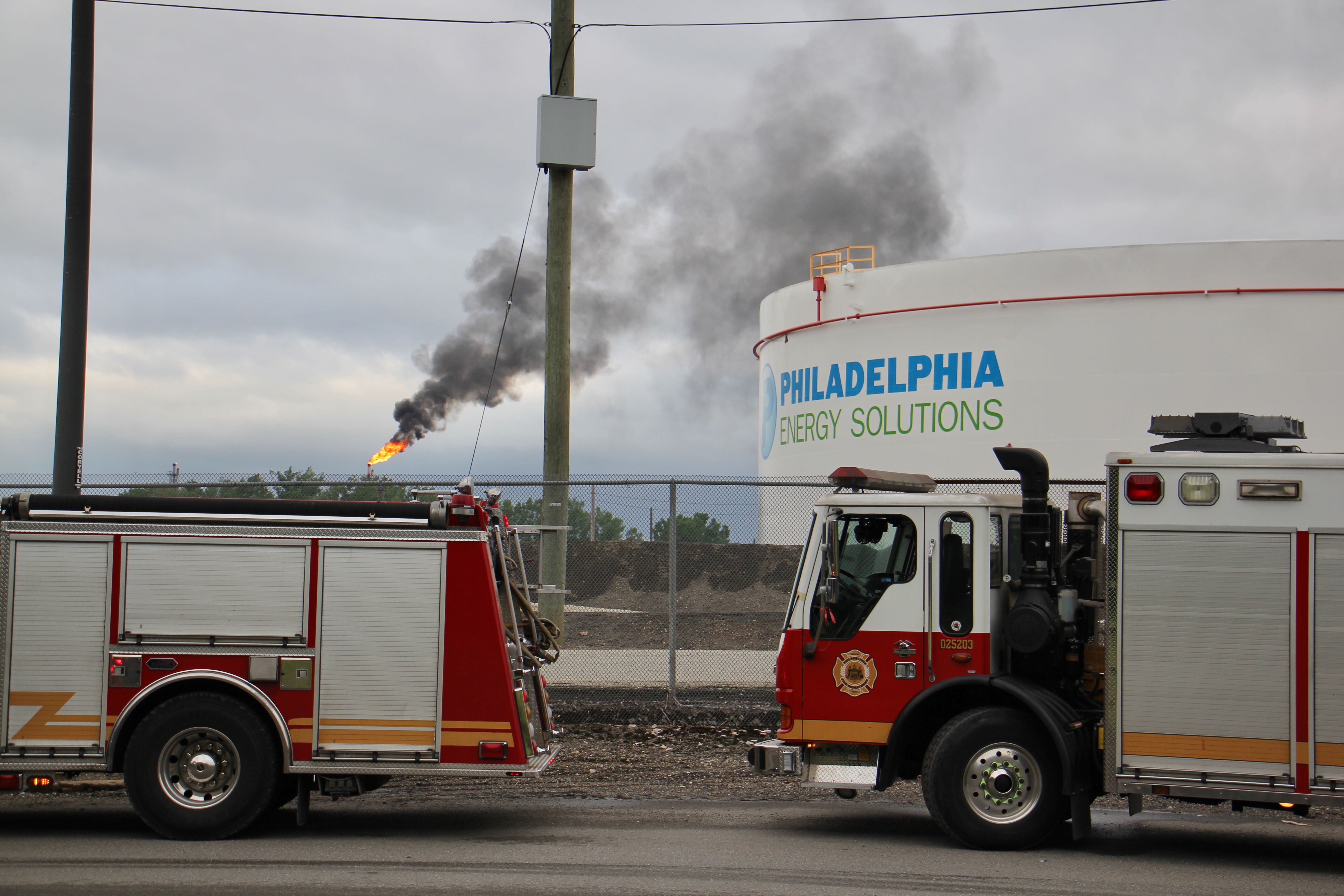
“Based on results of samples taken this morning, the Health Department has no findings that would suggest there is a threat to the public health as a result of today’s fire,” said James Garrow, a department spokesman.
The findings were based on two air samples taken from up- and down-wind of the refinery this morning.
Other local health experts are remaining more cautious.
“There definitely is a risk of toxic chemical exposure,” said Gretchen Dahlkemper, who runs her own children’s health and toxic chemicals policy consulting firm in Philadelphia.
Dahlkemper lives in Point Breeze, a neighborhood near the refinery, and is a mother of three. “My 8-year-old daughter has asthma, as do a high percentage of kids in our neighborhood,” she said.
In addition to children and infants, groups most affected by air pollution include elderly and pregnant individuals, as well as people who have existing respiratory or heart conditions, or are otherwise immunocompromised.
Marilyn Howarth, a doctor at the Center of Excellence in Environmental Toxicology at The University of Pennsylvania, agreed the fire could worsen symptoms for people with asthma and heart disease.
“There may be short term impacts on people with those conditions,” she said.
These diseases are also caused by other factors, such as smoking. So it’s often difficult to link individual cases directly to the refinery.
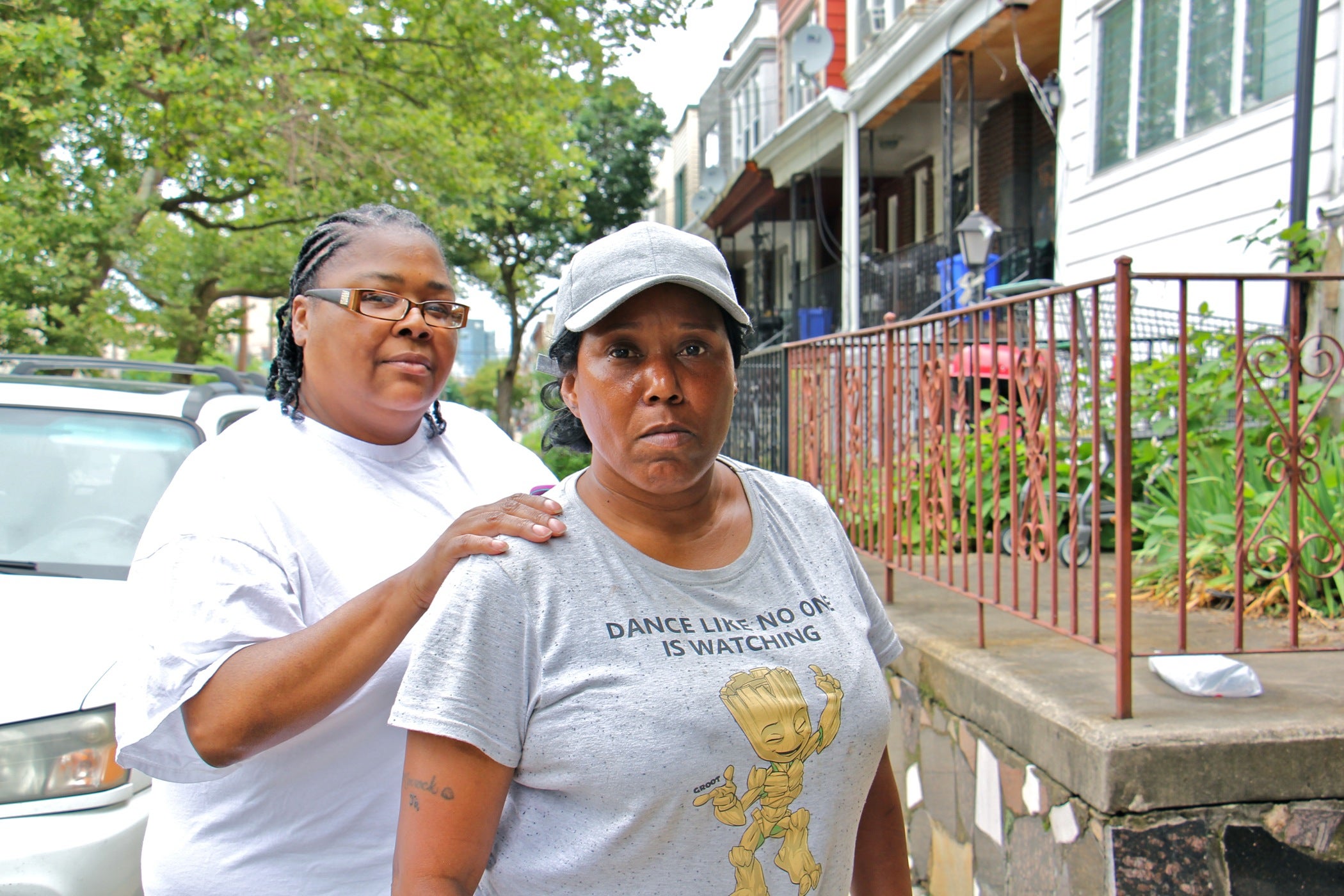
Kilynn Johnson and Sonya Sanders live downwind of the refinery in Grays Ferry. They are members of Philly Thrive, a community organization opposed to the plant.
“We’ve all been living here since we were kids. OK, this has been going on since our mothers were children. This has to stop,” said Sanders.
The pair referred to a smaller fire that occurred at the plant 11 days ago.
“It was a mild fire, so they say. But what is it going to take?” said Johnson. “Let us live, let us breathe fresh air. We don’t need to be any sicker than we already are.”
Sanders said foul odors from the refinery are common, and she and her neighbors suspect the refinery has made them sick.
“We smell it like it’s in our house. I have to go get blankets, put it down by the door, make sure my windows are shut and everything. And we are scared to death,” she said.
As of early Friday evening, the fire was no longer spreading, but still burning. After traveling northeast on Friday morning, smoke plumes turned southeast, in the direction of Deptford and Gloucester Townships in New Jersey, said Peter DeCarlo, an associate professor of engineering at Drexel University.
DeCarlo cautioned that the preliminary air monitoring is meant to ensure first responders aren’t in immediate danger. He said it shouldn’t be used to infer safety for community members.
“Emergency responders and firefighters are very, very healthy people,” he said. “People who are not healthy residents of the community — who might be elderly, or kids — are going to respond very differently to levels of pollution than those first responders.”
Over the next day, he said, everyone in the immediate vicinity or downwind of the refinery should try to limit their exposure to air pollutants and dust from the fire.
The best thing to do may be to leave the area until the fire is completely out and the smoke has dissipated, DeCarlo said. When the air is fresher, he said, people should open their windows and doors to flush their homes of air pollutants that have seeped in through cracks and crevices.
DeCarlo added that the wind, which was relatively strong Friday, will help clear the plume out pretty quickly once the fire is extinguished.
Those who can’t leave the area should stay indoors with the windows closed, said Blanca Himes, an assistant professor of biostatistics and epidemiology at the University of Pennsylvania.
If people start to feel symptoms such as shortness of breath, burning or itching sensations in their eyes or noses, fatigue, or headaches, they should seek medical care, Himes said.
“Some people are very sensitive to chemical smells, and they’ll know immediately that something is happening,” she said. She added, however, that not all pollutants have an odor.
‘Having my meal elsewhere’
Philadelphia Energy Solutions is the largest refinery on the East Coast processing 335,000 barrels of crude oil a day. It’s also the largest single source of air pollution in Philadelphia. It has never been in compliance with the Clean Air Act.
Philadelphia Energy Solutions said in a statement that there were three separate explosions at the refinery, which affected an alkylation unit.
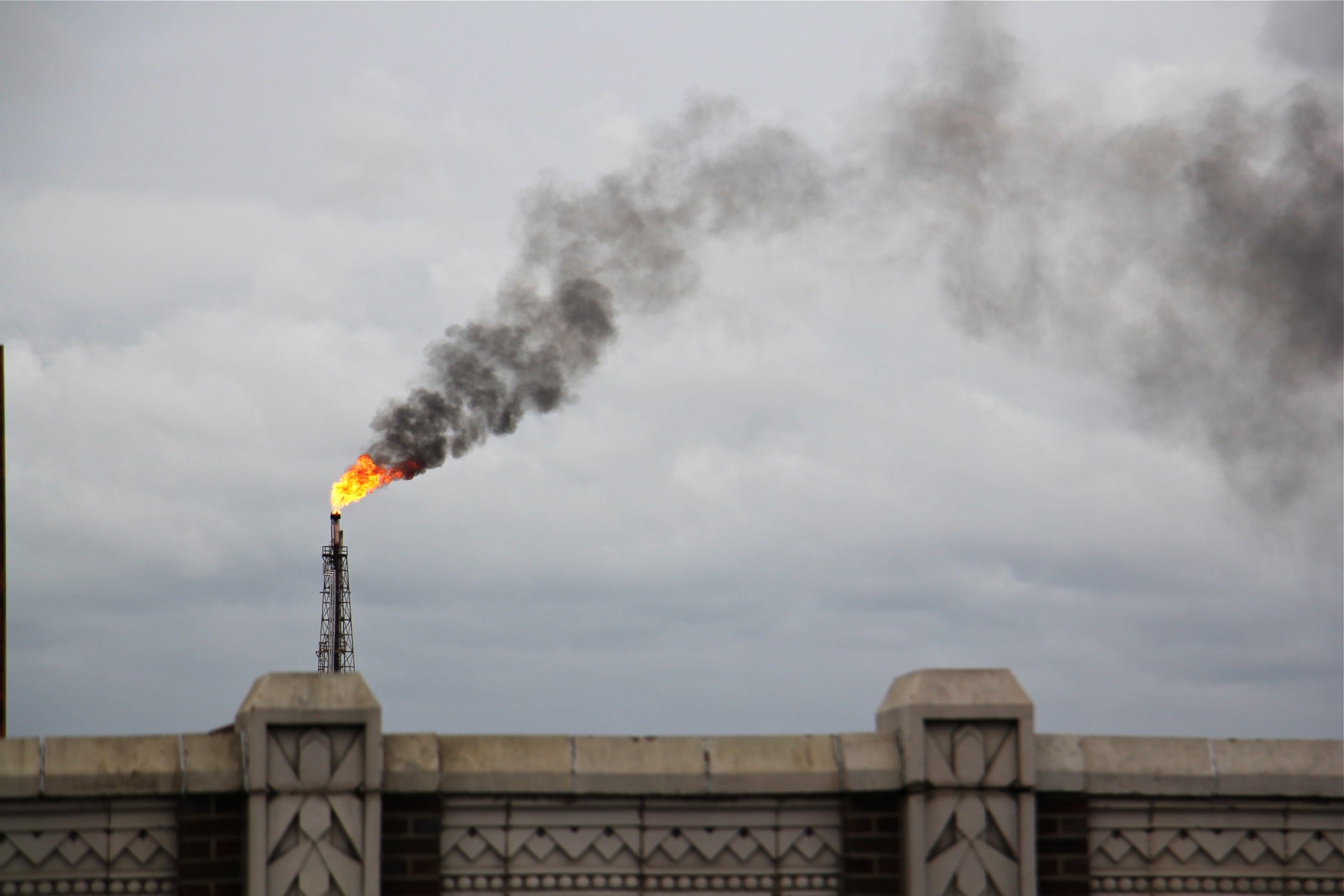
The company has not confirmed which products were burning, but suggested it was “mostly propane.” Earlier on Friday, Philadelphia fire officials stated that a butane vat ignited.
Reuters reported that one explosion may have occurred at an alkylation unit that uses hydrofluoric acid, one of the most dangerous and notorious chemicals in refining.
Advocates have long argued that hydrofluoric acid should not be used in the process. Under intense pressure, it can form a noxious vapor that destroys tissues.
“It’s a very caustic chemical, and it can cause a lot of damage,” DeCarlo said. “If you’re in a chemistry laboratory and you’re using hydrofluoric acid, you have to take extra precautions beyond what’s normal.”
If hydrofluoric acid is in the smoke plume, and “if it were me living in that area, I would certainly be having my meal elsewhere right now,” he added.
Pollution from the refinery, which is the largest on the East Coast, poses a range of health risks to nearby residents, including cancer, heart disease and respiratory diseases like asthma. The community surrounding the refinery is predominantly black and low-income.
“The pollution from the refinery is a silent killer, and we’re breathing that in,” said Sylvia Bennet, a resident of the nearby Grays Ferry neighborhood, in a statement put out by Philly Thrive, the community organization that has been fighting the refinery since 2015.
DeCarlo also called attention to the long-term effects of exposure to air pollution from the site.
“This is a refinery that’s been around since 1860 and has a long legacy of environmental issues. So just because we’re seeing the acute impacts or the immediate impacts of this fire doesn’t mean we should forget about the long-term and chronic impacts to the environment, and to the local people living in that area and their health,” he said.
Environmentalists and community organizations like Philly Thrive have called for the plant to shut down.
Philadelphia Energy Solutions released a statement apologizing to the community and says it is following protocol to protect the environment.
WHYY is your source for fact-based, in-depth journalism and information. As a nonprofit organization, we rely on financial support from readers like you. Please give today.


